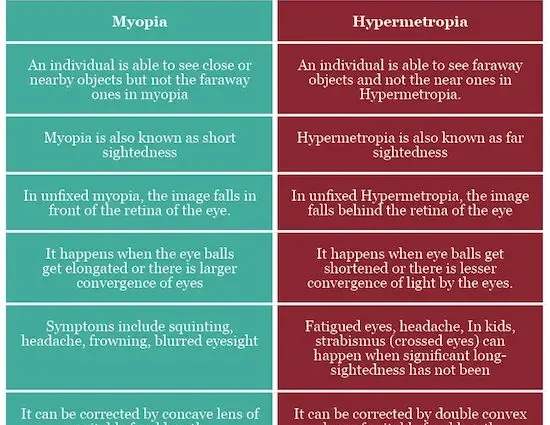Contents
What are the differences between myopia and presbyopia?
Myopia and presbyopia are two vision problems, but they do not have the same consequences or origins. Nearsightedness is a failure of the eye that can start very young, which prevents sharpness from afar. Presbyopia appears with age, and makes vision of nearby objects blurry.
Definitions
The clear vision is increasingly becoming the most important criterion in our societies where the image is omnipresent. We find it in our professions and administrative procedures, where screens are essential, but also in our leisure activities where television, cinema and mobile phones require a clear vision. Unfortunately, the human eye has some faults, the two main ones of which, myopia and presbyopia, must be corrected artificially.
Myopia
In France, myopia affects nearly 4 in 10 French people (Lien Le Monde). It consists in summary of an eye too elongated in depth. The difference is often very small, 24 mm deep instead of 23 mm in an emmetropic eye (without defect in sharpness). It is enough to make the vision blurry, since the light beams are focused not on the retina, but a few millimeters in front of it. The lens, placed behind the iris, can therefore do nothing, since its role is precisely to move the focal point forward, and not to move it back!
Most often myopic therefore sees very well up close, but blurry from afar.
Presbyopia
Unlike myopia, which is a building defect in the eye, presbyopia is one of the consequences of its natural aging. A bit like our knees bend less efficiently, and overall all our joints no longer have as much flexibility as when we were twenty, the eye also becomes less agile. More precisely, it is the crystalline which becomes less elastic. In a young eye, this membrane, a biconvex lens placed behind the iris, curves thanks to the presence of fibers to achieve theaccommodation. This act allows the focal point to move forward, to better see objects closer to us whose light rays arrive at a higher angle. With age, and the decrease in this elasticity, it becomes more and more difficult to accommodate, and the “maximum” focal distance obtained by the lens gradually decreases.
A presbyopic therefore sees well from a distance, but less and less well up close.
Symptoms and causes
In myopic
Symptoms of myopia appear quickly, most often in young children, during eye development. It is linked to an excessive depth of the eye, we then speak of axile myopia. Sometimes, however, it is the cornea that is too curved. Finally, it also happens that myopia is triggered by a degenerative disease, keratoconus.
The symptoms of myopia are therefore:
- Blurred vision distant objects. The notion of distance is relative, and can begin beyond ten centimeters.
- Clear vision, or at least better, close objects. Indeed, if the vision is permanently blurred, the problem may have other origins, such as astigmatism or other more severe complications (retinal or vitreous detachment).
- Headaches, for degenerating myopia: the myopic see less and less well but this progressive visual loss can initially go unnoticed.
The causes of myopia are more diverse, and still uncertain:
- Genetic, even if the precise gene has not been identified, it is proven that myopic parents are more likely to have a child who is also myopic. Likewise, certain ethnicities, such as Caucasians and Asians, seem more prone to becoming myopic.
- Child development, studies seem to indicate that children with little contact with outside light, or with excessive use of their eyes (for reading, watching videos, or playing video games) in their first five years are more likely to develop myopia.
- Diseases, as said above, keratoconus is a degenerative disease causing myopia but also a loss of distance vision.
At the presbyopic
Presbyopia starts with age, on average beyond 45 years.
The symptoms of presbyopia are:
- Progressive loss of near vision, with the need to move back books or phones to read better.
- Eye strain, given that the lens, which has become more rigid, is used more than before with each use.
- Headaches, a sign that the brain sees less and less clearly and needs more effort to decipher the signals sent by the optic nerve.
Treatments
Myopia like presbyopia can be treated in two ways.
- Le wearing glasses or contact lenses. By directly correcting the angle of the light beams, the focal point can be moved back to place on the retina. This requires seeing a optician who will choose for you the right corrections to apply.
- La eye surgery. Thanks to laser pulses, or precise optical instruments, we can now modify the curvature of the cornea (on the surface of the eye). This helps to settle myopia, but for presbyopia this operation will only be a temporary solution before further visual loss.










